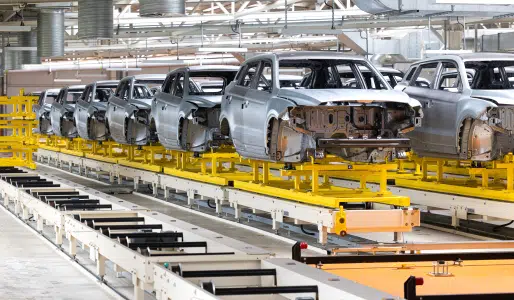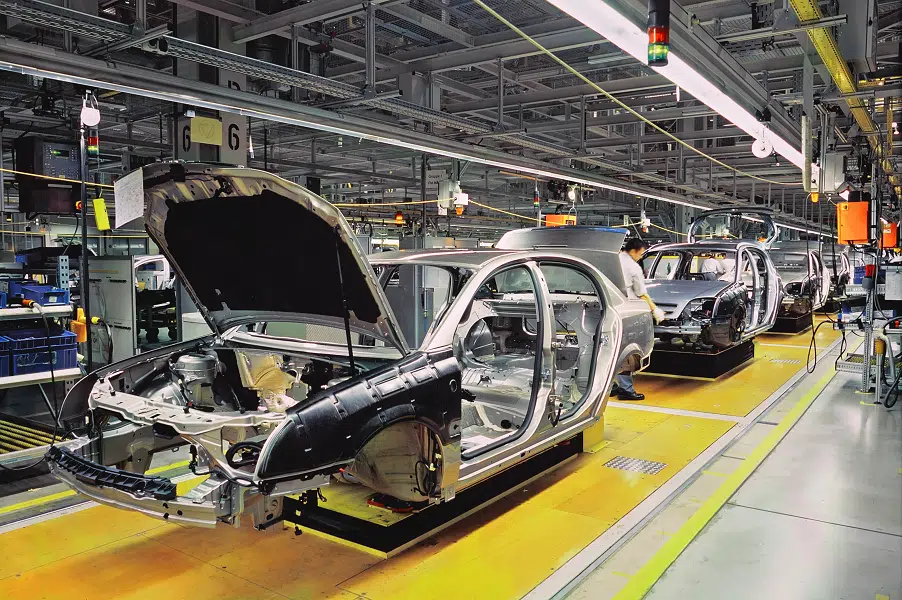SKID Conveying Systems & push SKID lines
Automotive engineering solutions from WinMOD
SKID Conveying Systems
Floor conveyor technology for car bodies
Conveyor technology with rollers and chains
Classic SKID Conveying Systems is undoubtedly one of the central elements in automotive engineering and is used in Body-in-white, paint buffers, pre-assembly and final assembly. WinMOD-SIMLINE provides a comprehensive 3D library of conveyor technology elements for virtual commissioning (VC). This includes roller conveyors and chain conveyors, rotary, lifting and traversing modules, and complex handling stations. These 3D elements are coupled with virtual drive components that include control-relevant behaviour and bus connection. These virtual devices can also be found in extensive WinMOD libraries.
The automation system to be tested is connected via classic fieldbus systems through configuration and signal imports from your automation software.


Large systems with many SKID modules
The challenge with VC for SKID systems is often the size and complexity of such systems, which can consist of several hundred individual conveyors and therefore naturally involve just as many SKID modules in motion. Added to this are hundreds of proximity sensors or light barriers. The WinMOD-SIMLINE real-time system is designed for such scenarios. Here, you can run your systems virtually at full capacity, just as you would later in real operation, and simulate buffering, sequencing, stopper logic or empty SKIDs in the feedback loop.
WinMOD Engineering and Layout Assistants and import functions make creating such large projects simple and efficient. To do this, you can integrate your project data and CAD drawings directly.
Push SKID lines
Floor conveyor technology with push platforms
Push SKID conveyor technology
With this floor-based conveyor technology, car bodies or heavy assemblies are moved along rails on large SKID platforms using a push mechanism. It is also common to switch between the push SKID rails and standard conveyor technology such as roller conveyors.
That is why the rails are part of the extensive 3D SKID library in WinMOD-SIMLINE. It includes conductor rails for supplying power and data to the SKID platforms. Code strips can also be defined on the rails. SKID transport is carried out by continuous or clocked feed. For this purpose, we simulate the driving, impact and congestion behaviour of virtual push SKIDs in real time, which enables cycle time analyses (car bodies/hour), for example.
One or two large conveyor control systems are usually used as the automation system. These are connected to the WinMOD system via the original fieldbus coupling, e.g. PROFINET. However, it is also possible to utilize virtual controllers such as PLCSim Advanced. For the coupling, import the projected hardware configuration and symbol list from your PLC project planning tool for both uses. In Virtual Commissioning (VC), you can test your original control software, the transitions between push SKID rails and standard SKID Conveying Systems, or the empty SKID return.


Push SKID platforms
Unlike traditional SKIDs, push SKID platforms are more complex, as they usually include lifting systems, their own controllers, current collectors or code readers. The WinMOD-SIMLINE 3D SKID library contains a selection of typical push SKID platforms. However, most platforms are manufacturer-specific platforms that simulate all real functions exactly. Here, we create tailor-made solutions exactly according to your requirements. To do this, the original CAD data is imported and the complete control-relevant behaviour is integrated. These WinMOD-SIMLINE elements are managed in customer-specific libraries.
Since VC systems are mostly used to test conveyor control systems, the platform controllers and local hub drives are often simulated directly in WinMOD. This has the great advantage that you do not need to have real platform controllers available for large systems with many SKIDs. With this WinMOD-internal behaviour, you can test the real control communication exactly, such as switching the platform controllers on and off when transitioning from and to the rail.
Further automotive engineering solutions
Production area in which structural body parts and outer skin parts are produced from sheet metal coils or cut-to-size blanks (blanks) by cold or hot forming – from the raw blank to the ready-to-install formed part.
Assembles stamped/formed sheet metal parts, extruded and cast components into a dimensionally accurate body structure – with defined geometry, rigidity, crash and NVH performance as the basis for the paint shop and final assembly.
Highly automated plant chains for surface pre-treatment, coating and curing of car bodies and add-on parts – designed for high throughput, reproducible appearance and corrosion protection.
Pre-assembly of front/rear axle modules as carriers for chassis, steering and drive units such as combustion engines, powertrains or electric axles. Transport to the sequenced handover to the „marriage“ with the body.
Highly automated process chain for the fabrication of traction batteries – from electrode production to cell assembly and forming to module/pack assembly
This area of technology encompasses conveyor systems that transport and sort pallets and mesh boxes containing automotive components. The conveyor elements are large roller and chain conveyors combined with lifting, rotating and shifting tables.
Fully automated high-bay warehouses, which are operated by light or heavy-duty storage and retrieval machines and controlled by distributed automation systems. Warehouse management systems generate the orders for storing and retrieving raw components or complete car bodies.
Ground-based conveyor technology in which car bodies or heavy modules are transported on standardised SKIDs (steel frames with vehicle-specific support points) through assembly, paint shop and buffer areas.
Overhead conveyor systems with electrically driven, individually controllable trolleys on monorail tracks for low or high loads (up to tonnes).
Ground-based conveyor technology in which car bodies or heavy assemblies are moved on platforms along rails. The drive is typically provided by friction wheels, push chain conveyors or push beams, which continuously push the SKIDs forward.